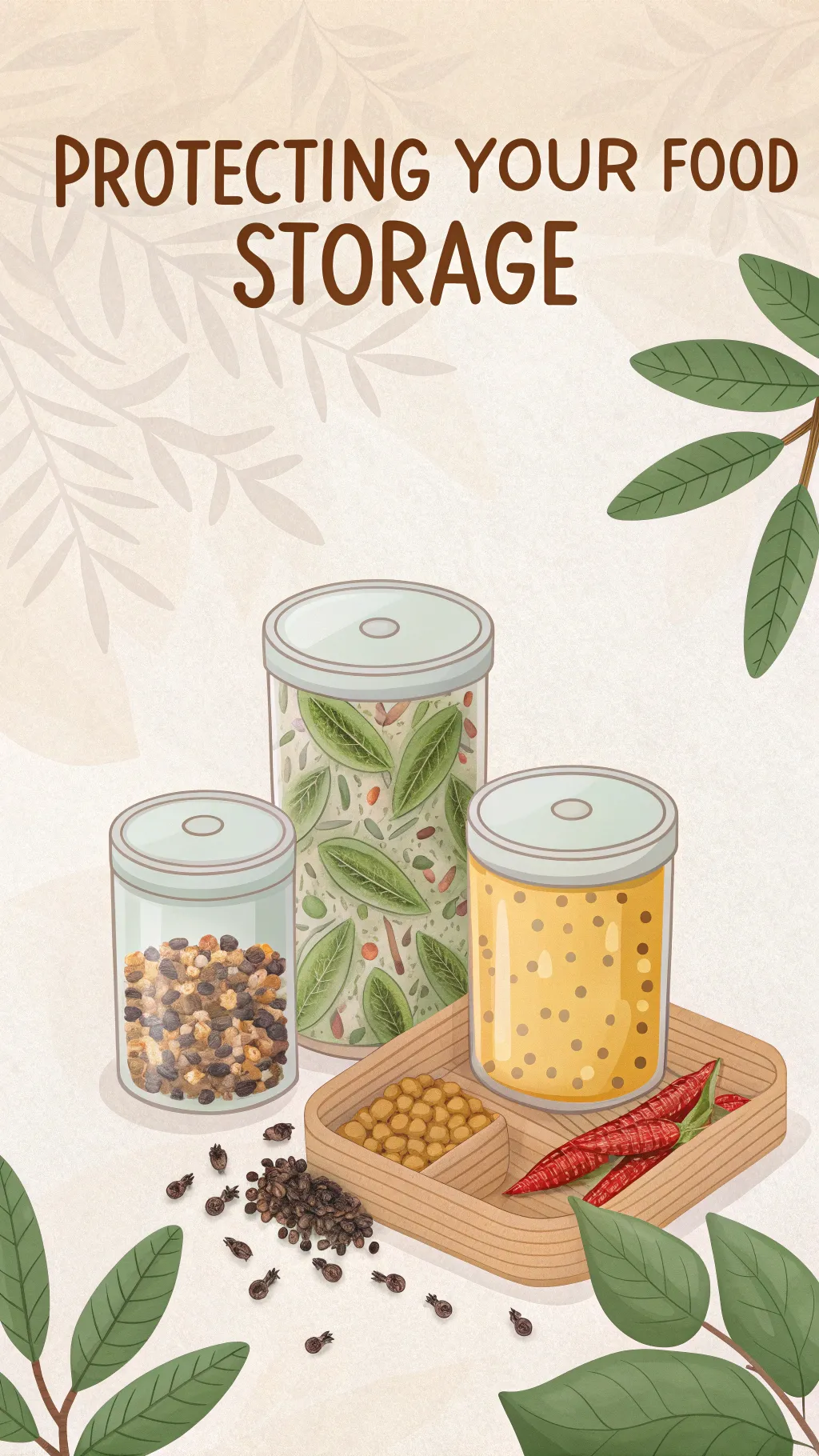Pantry Moth Home Remedy Protecting Your Food Storage
You open your pantry door. Tiny moths flutter out. Dread fills your heart. They hover near your favorite herbs. They target your healthy grains. This feels deeply unsettling. You work hard for a natural home. These pests invade your sacred space.
Pantry moths find our pantries appealing. They love organic staples. Flour, nuts, and dried fruits draw them. Dried herbs are special targets. My own pantry holds many natural ingredients. I know the frustration well. You need ways to fight back. These methods must be safe. Harsh chemicals do not belong here.
I created this guide for you. It shares natural answers. Learn effective Pantry moth home remedy steps. We explore natural methods. Simple DIY pest control works. I will show you how. Find where they hide. Learn to stop them. Use natural treatments safely. Keep your pantry clean and safe. Build a truly natural home solutions. Create a healthy home environment for your ingredients.
Okay, let’s dive into tackling those unwelcome pantry guests naturally. As someone who relies on a well-stocked pantry of herbs and natural ingredients, I know how frustrating these little critters can be.
Understanding the Invaders: Identifying Pantry Moths
You must know your enemy. Pantry moths are tiny pests. We usually see the Indian Meal Moth. This is the most common one. They love dried foods. Grains, flour, nuts are favorites. They also target dried herbs. My own herbal stash needs protection.
Moths have a life cycle. It has four main steps. First are tiny eggs. They are hard to see. Eggs hatch into larvae. Larvae look like small worms. They eat your food items. This is the damaging stage. Next, they form a pupa. It looks like a cocoon. Pupae hide in corners. Finally, an adult moth appears. The adult moth flies around. It looks for a mate. Then it lays more eggs. Understanding this helps us fight them. We need to break this cycle.
Look for certain signs. See any fine webbing? It might be in food bags. Check corners of packages. Look inside containers. You might see small larvae. They crawl around food. Pupae look like grains of rice. They hide in crevices. Adult moths fly at dusk. They move in a zig-zag way. I have seen this flight pattern often.
They hide in many places. Cracks in shelves hide them. Corners are favorite spots. Look under shelf liners. Check inside food packages. Flour bags hide them. Cereal boxes too. Nuts and dried fruit packages host them. Birdseed and pet food attract them. My dried herbs and spices are vulnerable. Check these carefully.
Protecting your ingredients matters. Your organic herbs are valuable. Your medicinal spices are key. Whole grains are healthy food. These pests threaten your natural pantry.
- Actionable Tip: Check your pantry today. Look closely at all items. Inspect shelves and corners. Search for webbing or larvae. This first step is important.
Prevention is Paramount: Natural Strategies to Keep Moths Out
Stopping moths before they start is best. This is the top Pantry moth home remedy. Prevention saves you trouble. It protects your food.
Airtight storage is crucial. Transfer dry goods right away. Use sturdy containers. Glass jars work very well. Thick plastic containers are okay too. Move flour, grains, nuts. Put dried fruits in jars. Store pasta and cereal safely. Place your dried herbs in sealed jars. This keeps moths out. It also keeps pests from spreading. I always use glass jars now.
Inspect groceries before storing. Look at bulk items closely. Check bags for tiny holes. Make sure packaging is sealed. Do this before putting them away.
Clean your pantry often. Make it a regular habit. Crumbs feed pantry pests. Spills attract them too. Wipe down shelves weekly. Clean up any mess quickly. This removes food sources. Regular cleaning prevents buildup.
Keep the pantry cool and dry. Moths like warmth and moisture. Lower temperatures help. Good airflow is good.
Some herbs may help prevent them. These are herbal pest control ideas.
Bay leaves are traditional. Place fresh bay leaves on shelves. Put them in cabinets. Some people put leaves in containers. Airtight jars are better though. Moths might dislike the scent. I have used bay leaves for years. It feels like an old wisdom.
Other scents are mentioned. Peppermint or cedar scents might deter some pests. Bay leaves are most common for pantries.
Keeping a healthy home environment is key. Airtight storage helps. Regular cleaning helps. It keeps your pantry clean. It reduces food waste. This aligns with a sustainable home. Glass jars are popular now. They look nice and work well.
- Actionable Tip: Get airtight containers today. Transfer your dry goods. Make a weekly cleaning plan. Add it to your routine.
Natural Home Remedies for Active Infestations
Moths are already here. You need to act fast. Natural Pantry moth home remedy methods work. They need careful work.
First, do a big cleanout. This step is essential. Empty your whole pantry. Take everything out. Inspect every single item. Look for webbing, larvae, moths. Infested food must go. Seal it tightly in bags. Take the bags outside immediately. Throw them in an outdoor trash can. It is hard to throw food away. But it stops the problem.
Vacuum the empty pantry. Vacuum shelves and walls. Get into corners. Vacuum the ceiling edges. Vacuum the floor. Focus on cracks and crevices. Eggs and pupae hide there. Vacuum up any crumbs. Take the vacuum bag outside. Dispose of it right away. If you have a bagless vacuum, empty it outside. Wash the canister well.
Clean surfaces with natural solutions.
Make a vinegar wash. Mix white vinegar with water. Use equal parts. Wipe down all pantry surfaces. Clean shelves, walls, door. Vinegar kills eggs and larvae. It removes scent trails too. Open a window for air. Vinegar smell is strong.
Hot, soapy water works too. Wash surfaces thoroughly. This also cleans effectively.
Use DIY pest control traps. These catch adult moths. They help break the cycle.
Make simple vinegar traps. Put apple cider vinegar in a bowl. Add a drop of dish soap. The soap breaks surface tension. Moths are drawn to the smell. They land and fall in. They cannot get out. Place these traps on shelves.
Pheromone traps are an option. You buy these traps. They use a scent. The scent attracts male moths. Males get stuck on a sticky surface. This is non-toxic moth solutions. They are good for monitoring. They reduce breeding. They do not kill eggs or larvae.
After cleaning, use scents carefully. Place fresh bay leaves again. Put them on clean shelves. Keep them away from food.
Diluted essential oils can help. Use peppermint or citrus oils. Mix a few drops with water. Or mix with vinegar solution. Wipe clean surfaces with this mix. Do not spray near food. Ensure good ventilation. Essential oils are strong. Use them safely. Keep them from pets and kids.
These methods work together. Cleaning is the most important part. Traps help catch adults. Natural scents might deter them. Use caution with all remedies.
- Actionable Tip: Clear your pantry today. Inspect and discard infested items. Vacuum and clean thoroughly. Set up vinegar traps.
The Cleanup Deep Dive & Long-Term Prevention
After the big clean, keep going. Check areas near the pantry. Moths can move away. Look on ceilings and walls. Check edges near the pantry door. Pupae might hide there. Look under nearby appliances.
Sometimes you can save items. This is tricky though. Expensive nuts or grains might be saved. Often, discarding is best. If you try to save food:
Freeze items for days. Put the sealed food in a freezer. Keep it at 0°F or lower. Leave it for 3 to 4 days. This kills eggs and larvae.
Heating also works. Put items in an oven. Use a very low heat. This also kills pests. Freezing is usually easier.
Stay watchful after cleaning. Pantry moth control needs attention. Check your pantry regularly. Look for new signs.
Rotate your food stock. Use older items first. Don’t let things sit for long. This prevents pests from settling in.
Find the source if moths return. Maybe they came from outside. Pet food stored elsewhere might be it. A hidden spill could be the cause.
Let me share a story. My friend Sarah loves herbs. Her pantry was her treasure. It held bulk herbs. She made her own teas. Moths appeared everywhere. She felt awful. Her valuable collection was at risk.
She decided to use natural methods. No harsh chemicals for her. She emptied everything out. She vacuumed every crack. She used a vinegar wash. Then she transferred food. All grains and nuts went into jars. Her dried herbs went into airtight glass. She placed bay leaves everywhere. She put out vinegar traps.
It was hard work. She had to throw out some herbs. But most were saved. The cleaning took hours. Repacking took more time. She felt relief though. Her pantry was clean. The moths disappeared. She kept checking often. She kept her food in jars. She cleaned shelves weekly. Natural home remedies for pests worked. It saved her herbal pantry.
- Actionable Tip: Check nearby areas after cleaning. Consider freezing valuable items. Start using older food first. Make a plan for checking your pantry.
Deep Dive into DIY & Herbal Pest Solutions
Let’s look closer at natural tools. These connect to herbs and natural living.
Bay leaves offer more than soup flavor. People use them traditionally. They are a simple herbal pest control. The idea is moths dislike the smell. Place fresh leaves on shelves. Put them where food is stored. Remember airtight containers are best. Bay leaves add an extra layer. It fits the home remedy idea.
Essential oils can help with cleaning. Use them safely on surfaces. Peppermint, tea tree, lemon work. Dilute them heavily first. Mix with water or vinegar. Wipe down cleaned shelves. Do not spray near food. Ensure good airflow. These oils smell nice. They might make the area less inviting. Use dilution ratios carefully. Keep oils away from kids and pets.
Vinegar is a powerful cleaner. Its acidity helps kill eggs. It breaks down residues. The trap works simply. Moths are attracted to the smell. The soap makes them sink.
Make DIY pest control scent sachets. Use small cloth bags. Fill them with dried peppermint. Or use dried lavender. These repel other moths. They might help near the pantry. Place them outside containers. Or put cotton balls with diluted oil. Keep them far from food items.
These DIY pest control methods are empowering. You use simple ingredients. Many are already in your home. It aligns with natural living. It feels self-sufficient.
Natural, non-toxic homes are popular. DIY pest control fits this trend. People want fewer chemicals. You can source quality bay leaves. Look for organic ones. Choose pure essential oils.
- Actionable Tip: Try placing fresh bay leaves. Make a simple natural cleaning spray. Use diluted essential oils safely. Keep it away from food.
Integrating Pantry Health into Holistic Home Wellness
Let’s connect this pest control to wellness. Your pantry is important. It holds healthy food. It stores natural remedies. Herbs, spices, whole foods are there. Protecting these ingredients protects your health. It is a foundation for wellness.
Choosing natural Pantry moth home remedy methods matters. It creates a healthy home environment. You reduce chemical exposure. Conventional pesticides use harsh substances. Natural methods avoid this. This is key for health-conscious people.
Regular cleaning feels good. Organizing your pantry helps. It brings a sense of order. This can contribute to well-being. It is like caring for your space. Ayurveda talks about cleanliness. Saucha means purity. Keeping your home clean supports this idea.
Preventing infestations saves food. Properly storing items reduces waste. This aligns with sustainable living. People care more about this now. It is a 2025 trend.
A clean pantry brings joy. It gives peace of mind. You know your food is safe. Your nourishing ingredients are protected. It feels good to open the door.
- Actionable Tip: Spend 10 minutes today. Tidy a small part of your pantry. See how it feels. Make it a weekly habit.
Common Questions About Pantry Moths
People ask me about pantry moths often. They are a common problem. Here are answers to your questions. These help you use Pantry moth home remedy ideas.
How do I know if I really have pantry moths?
Look for certain signs. See any fine webbing? It might be in food bags. You might see small worms. These are the larvae. Pupae look like cocoons. They hide in corners. Adult moths fly around. They flutter in the evening. These signs tell you they are there.
Are these natural home remedies actually effective?
Yes, they can work very well. You must be thorough. Cleaning is key. Natural methods break the life cycle. They deter new pests. You avoid harsh chemicals. It is a safe way to manage them. Natural healing applies to your home too.
Are pantry moth home remedies safe to use around food?
Many methods are safe. Airtight storage is very safe. Cleaning with vinegar is safe. Just air out the space. Bay leaves are traditionally used. They are okay near food. Use essential oils carefully. Put them on cleaned surfaces only. Dilute them well. Keep them from food items.
How long does it take to get rid of pantry moths using these methods?
It takes time and effort. The time depends on the problem size. You need several weeks. You must catch all stages. Be consistent with cleaning. Keep using prevention steps. It is an ongoing process.
Can I reuse containers that had moths?
Yes, you can reuse them. Wash them very well. Use hot, soapy water. Run them through the dishwasher. This kills any eggs left. Then they are safe for food. This saves money too. It fits home remedy recipes ideas for cleaning.
Getting rid of pantry moths feels good. It protects your food. Natural methods work well. Pantry moth home remedy steps are effective. You use safe natural home solutions.
We talked about finding them. We covered cleaning your space. Prevention is very important. DIY pest control protects your pantry. These methods keep them away.
Using natural ways helps you. You keep your ingredients safe. Your pantry holds health resources. This creates a healthy home environment. It feels great to have a clean pantry.
Take a look in your pantry. Try one natural step today. Start with airtight jars. Or maybe a quick clean. Share your own tips too. We learn together this way.
Jamie Carter
Jamie is deeply committed to holistic wellness, blending natural, home, and homeopathic remedies into her family’s daily life. She lives in a suburban home with a small herb garden where she grows plants like chamomile and lavender for remedies. Jamie spends her mornings teaching yoga and her afternoons researching or preparing remedies for her family’s health needs. She’s active in local wellness communities, often attending workshops on homeopathy and natural healing, and prefers gentle, non-invasive solutions over conventional medicine.
Goals and Motivations
Primary Goal: To support her family’s health using natural, home, and homeopathic remedies that are safe and effective.
Secondary Goal: To deepen her knowledge of homeopathic principles and share reliable remedies with her clients and community.
Motivations: Jamie is motivated by her belief in the body’s ability to heal itself with minimal intervention. She values remedies that are personalized, sustainable, and aligned with homeopathic philosophy, such as using highly diluted substances to stimulate healing.



